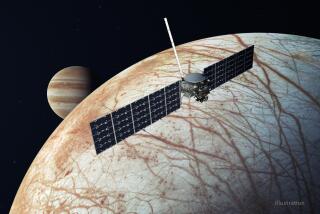Edward Stone
- Share via
PASADENA — The Pathfinder spacecraft is more than halfway to a dramatic rendezvous with Mars. On July 4, it will dive through the Martian atmosphere trailing a parachute. Air bags will inflate to cushion its impact and, soon, it will be relaying panoramic images of the surface of Mars back to Earth.
Then a small rover called Sojourner, its solar cells coaxed to life by the sun, will leave Pathfinder and drive off onto the ancient Martian flood plain.
At the Jet Propulsion Laboratory in Pasadena, the creators of Pathfinder and Sojourner will be gathered around an indoor sandbox to watch scale mock-ups of the spacecraft.
For Dr. Edward C. Stone, director of JPL, it will be the beginning of another adventure--a decade-long, robotic exploration of Mars. But it also is the first step in a new era of space exploration for his laboratory. The days of the once-in-a-decade, multibillion-dollar missions are coming to a close, with the launch of the $2.7 billion Cassini mission to Saturn later this year. And Stone is leading the laboratory into a future where space probes will be smaller, cheaper, faster and more plentiful.
Pathfinder cost $171 million; the rover $25 million. The current plan is to send two missions to Mars every 26 months until 2005, when samples from the planet’s surface will be returned to Earth for study.
Stone, a 61-year-old physics professor at Caltech, has been JPL director since 1991. But he has been a key figure at JPL since becoming chief scientist for the Voyager mission 25 years ago. After five years of planning, the twin Voyager spacecraft were launched in 1977 and the mission eventually encountered Jupiter, Saturn, Uranus and Neptune. Even today, as Voyager speeds toward interstellar space, it is still sending back data. And that will continue for two more decades.
Stone was born in Iowa and earned master’s and doctor’s degrees in physics at the University of Chicago. He had just begun studying physics at the University of Chicago in 1957, when the space age began. During his career, he has been a principal investigator on nine NASA spacecraft mission and co-investigator on five others.
The JPL director is a friendly, bespectacled scientist who works from an office with large windows facing north, toward the domed home of the laboratory’s tracking antennas and the stark mountains beyond. He lives in Pasadena, near his Caltech office, and he and his wife, Alice, have two children and two grandchildren. Energetic and engaging, he remains entranced by the frontiers of space travel.
A seminal moment in his career was Voyager’s 1979 discovery of volcanoes on Io, a Jovian moon. It was the kind of discovery, he says, “that makes you realize you had too narrow a view of what the solar system is. We just hadn’t been smart enough to ask the right questions. That was our first encounter with the frontier of knowledge. And wow.”
Now Stone’s mission is to guide JPL into a new era of cost-cutting, downsizing and outsourcing. JPL, owned by NASA and operated under contract by Caltech, recently announced plans to cut its work force from 6,100 to about 5,000 by the year 2000. It also is using nearly half its $1-billion budget to hire contractors to handle more of its work.
But, Stone insists, the science will remain unaffected.
*
Question: How much has technology advanced in the last decade in terms of space travel?
Answer: The leaps in computing power have been enormous. In sensor systems, we’re just beginning to make the breakthroughs. If you buy a camcorder, the device in there which makes the image is called a CCD (charge-coupled device). We have developed a replacement for the CCD that uses 1/100th of the power of the CCD. And that’s important. If you want to build a smaller spacecraft, you need smaller [instruments, smaller] solar panels, less power. That technology was not there 10 years ago.
Q: And where are improvements still needed?
A: We are not yet there in terms of revolutionizing spacecraft design, but part of the president’s budget request this year will allow us to take the next step to reduce the mass of these spacecraft. That reduces the cost of the craft and also the cost of the launch vehicle. These are the kinds of breakthroughs we’re driving for. We want to press the technology frontiers of space. That’s the role of NASA. That’s the role of a place like JPL.
Q: Is there a danger in this business that you won’t think grandly enough, that you’ll be limited by your own imagination?
A: That’s a good point. NASA was originally established in 1958 in order to bring the U.S. into the space age. The U.S. today is clearly a space-faring nation.
So what is NASA’s new role? I think it is to continue to expand the boundaries of space. If we aren’t thinking about doing things we haven’t done before, we’re not doing the job we need to do for the nation.
Q: Over the years, there have been spikes in public interest in space exploration. Does the public still have a lot of interest in what you do?
A: There is still a lot of interest. Galileo dropping a probe into Jupiter was a very exciting time. A year before it was the Shoemaker-Levy impacts with Jupiter. Our home page had a million hits in the first week after Shoemaker-Levy.
The worldwide web is really changing the way people can become engaged in the space exploration program. I like the term engagement. While it’s scientifically important, there also is--a sense of exploring, a sense of a future that holds opportunities to go somewhere or to learn something that we didn’t already know.
Q: Is that interest reflected in Washington?
A: Up until this year there has been a serious problem. The NASA budget had been going down and down and, in fact, last year was really the nadir. The president’s budget [plan for the year 2000] was $11.6 billion, down from $13.7 billion. This year, the president has suggested a budget that is about $13.2 billion in the year 2000, which does stabilize the program.
Q: JPL recently announced plans to decrease the size of its work force and privatize some functions. Will scientists be involved in that?
A: There are two areas we’re focusing on. We are putting in a new business system for financial, accounting, purchasing and human resources.
The other area of downsizing is in the area of ground data systems and mission operations. We’re not totally getting out of either area; we still need in-house capability. But there is a certain part of that activity we can now rely on industry to do. We are going to focus our work force on doing the things that industry cannot do for us.
Q: What’s the likely effect of this on the science?
A: Well, if we do this correctly, there should be no effect on the science.
Q: You spoke earlier about the need to press the frontiers. Is that being done by scientists on individual projects or in basic research?
A: You need basic research, but a lot of that is done in the universities. One of the key things we can do here at JPL, which cannot be done so easily at universities or industry, is to take that basic technology and put it into practice.
One of the most interesting ones was [in 1964]. In order to get images back from Mars, there was no way we could send back an analog TV picture, the kind of TV we still have today. So we had to develop digital telecommunications. It wasn’t a new idea, but we had to reduce it to practice. Today digital images are used in doctor’s offices and home computers everywhere--all because of the demands of deep space exploration.
So it is the demands of doing these things at great distances, at low powers, at low sunlight, at cold temperatures, you name it. We reduce technology to practice.
Q: Recently, there has been a lot of talk in America about the importance of teaching basic science to America’s children. Your thoughts?
A: The U.S. is really very fortunate that its college educational program is as good as it is, because it has to make up for a very serious shortfall in the secondary educational program. That works reasonably well for those who go to college. It obviously does nothing for those who don’t go to college.
Q: What is the solution?
A: To somehow do a better job, especially at the secondary-education level, of helping people deal with an increasingly technical society. They don’t have to be mathematicians or scientists, but they at least have to understand enough to be able to deal with all of the tools of a modern society.
Q: Is JPL helping solve this problem?
A: Although we are not in the education business here at JPL, we are in the space exploration business. And clearly the interest in space exploration by students is a handle, a hook. And so we’re trying to form partnerships with teachers to help them use the motivation and science associated with space.
Q: What are the most important new space frontiers? The search for life?
A: Clearly, one of the major discoveries that could come from space science is if we find that life did evolve at one time on Mars.
There was a lot of water on Mars 3.5 billion years ago. Here on Earth, wherever there is water, we have now found life. Whether it was nearly boiling water or nearly freezing water, whether its water inside rocks two miles below, it doesn’t matter. Life is there.
So it’s hard to imagine that it didn’t evolve on Mars. The question is: Can we find any evidence that it did? And, if we can, is it similar to life here on Earth or is it somehow fundamentally different? Is the DNA, the mechanism that controls life on planet Earth, more universal, or is it just one example of life?
Q: And what of other civilizations?
A: Not in our solar system. We know there are none in our solar system. But an exciting thing, I think, is the possibility of being able to detect Earth-like planets around other stars. That is a real technology stretch.
We don’t know how to do that today but, again, part of the president’s budget request this year has in it, as a long-term objective, an attempt to detect Earth-like planets around other stars.
As a first step to that, we will build an optical system that allows two telescopes in space to effectively function as a single more powerful one. If we can do that, we can actually isolate Earth-like planets around nearby stars and analyze the atmospheres of those planets to see if there is any evidence that simple life has evolved.
And that could happen within 10 to 15 years.
Q: As for the mission that lands on Mars on July 4, how soon will we know if there is life on Mars?
A: This mission is not equipped to do that. Our basic strategy is that every two years we will send an orbiter and a lander [to Mars]. The orbiter will look for the most interesting spots where there was water and then the lander will go there.
And, in 2001 and 2003, we will send very sophisticated rovers that will look at the rocks and decide which ones are the most likely to have evidence of life. They will not be able to analyze the rocks in detail; that is barely possible to do here on Earth. But they will collect those rocks on a spot on Mars and leave them there.
Then we will send another mission to bring those samples back to Earth, where we could then examine them.
Q: Do you think there was life on Mars?
A: I think it seems unlikely, with water having been there, that simple life did not evolve. In fact, if there wasn’t life, that would be remarkable. Many people believe it is likely that simple life did evolve on Mars because we find it in so many places here on Earth now, places that 20 years ago, nobody would have imagined.
Q: And life elsewhere in the solar system?
A: Another very interesting object is the moon Europa, which is in orbit around Jupiter. Unlike our moon, it has a thin ice crust. There are no mountains and no valleys. It looks like ice pack on liquid water ocean.
Now the question is: Is it still liquid today? If there is still today a liquid water ocean somewhere in the solar system, it’s got to be a place we’re going to want to explore in detail, because it was in the oceans that we believe life began here on Earth. And we now know life can thrive without sunlight. We see it in our mid-ocean ridges where thermal vents provide the chemical energy for life.
Q: We’re talking about microscopic life?
A: Yes, this is all microscopic life. Certainly, around thermal vents, we see microscopic bacteria that are at the bottom of the food chain. And there are higher life forms that live on that bacteria. But no intelligent life.
Q: JPL in the year 2010. What will it look like?
A: JPL is primarily an engineering organization and it will continue to be one. And we will still be working with teams of scientists from universities around the world.
I mean, this is the world’s gateway to the solar system. There is a very exciting future.







